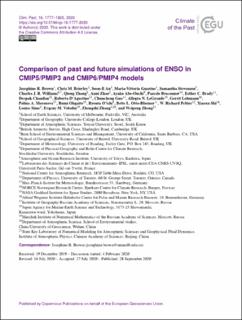Comparison of past and future simulations of ENSO in CMIP5/PMIP3 and CMIP6/PMIP4 models
| dc.contributor.author | Brown, Josephine | |
| dc.contributor.author | Brierley, Chris | |
| dc.contributor.author | Soon-Il, An | |
| dc.contributor.author | Guarino, Maria-Vittoria | |
| dc.contributor.author | Stevenson, Samantha | |
| dc.contributor.author | Williams, Charles J. R. | |
| dc.contributor.author | Zhang, Qiong | |
| dc.contributor.author | Zhao, Anni | |
| dc.contributor.author | Abe-Ouchi, Ayako | |
| dc.contributor.author | Braconnot, Pascale | |
| dc.contributor.author | Brady, Esther C. | |
| dc.contributor.author | Chandan, Deepak | |
| dc.contributor.author | D'Agostino, Roberta | |
| dc.contributor.author | Guo, Chuncheng | |
| dc.contributor.author | Legrande, Allegra N. | |
| dc.contributor.author | Lohmann, Gerrit | |
| dc.contributor.author | Morozova, Polina A. | |
| dc.contributor.author | Ohgaito, Rumi | |
| dc.contributor.author | O'ishi, Ryouta | |
| dc.contributor.author | Otto-Bliesner, Bette L. | |
| dc.contributor.author | Peltier, W. Richard | |
| dc.contributor.author | Shi, Xiaoxu | |
| dc.contributor.author | Sime, Louise C. | |
| dc.contributor.author | Volodin, Evgeny M. | |
| dc.contributor.author | Zhang, Zhongshi | |
| dc.contributor.author | Zheng, Weipeng | |
| dc.date.accessioned | 2021-01-19T10:11:56Z | |
| dc.date.available | 2021-01-19T10:11:56Z | |
| dc.date.created | 2021-01-13T10:54:53Z | |
| dc.date.issued | 2020 | |
| dc.identifier.issn | 1814-9324 | |
| dc.identifier.uri | https://hdl.handle.net/11250/2723626 | |
| dc.description.abstract | El Niño–Southern Oscillation (ENSO) is the strongest mode of interannual climate variability in the current climate, influencing ecosystems, agriculture, and weather systems across the globe, but future projections of ENSO frequency and amplitude remain highly uncertain. A comparison of changes in ENSO in a range of past and future climate simulations can provide insights into the sensitivity of ENSO to changes in the mean state, including changes in the seasonality of incoming solar radiation, global average temperatures, and spatial patterns of sea surface temperatures. As a comprehensive set of coupled model simulations is now available for both palaeoclimate time slices (the Last Glacial Maximum, mid-Holocene, and last interglacial) and idealised future warming scenarios (1 % per year CO2 increase, abrupt four-time CO2 increase), this allows a detailed evaluation of ENSO changes in this wide range of climates. Such a comparison can assist in constraining uncertainty in future projections, providing insights into model agreement and the sensitivity of ENSO to a range of factors. The majority of models simulate a consistent weakening of ENSO activity in the last interglacial and mid-Holocene experiments, and there is an ensemble mean reduction of variability in the western equatorial Pacific in the Last Glacial Maximum experiments. Changes in global temperature produce a weaker precipitation response to ENSO in the cold Last Glacial Maximum experiments and an enhanced precipitation response to ENSO in the warm increased CO2 experiments. No consistent relationship between changes in ENSO amplitude and annual cycle was identified across experiments. | |
| dc.language.iso | eng | en_US |
| dc.rights | Navngivelse 4.0 Internasjonal | * |
| dc.rights.uri | http://creativecommons.org/licenses/by/4.0/deed.no | * |
| dc.title | Comparison of past and future simulations of ENSO in CMIP5/PMIP3 and CMIP6/PMIP4 models | en_US |
| dc.type | Peer reviewed | en_US |
| dc.type | Journal article | en_US |
| dc.rights.holder | © 2020, Authors | |
| dc.description.version | publishedVersion | |
| cristin.ispublished | true | |
| cristin.fulltext | original | |
| cristin.qualitycode | 1 | |
| dc.identifier.doi | 10.5194/cp-16-1777-2020 | |
| dc.identifier.cristin | 1870432 | |
| dc.source.journal | Climate of the Past | en_US |

